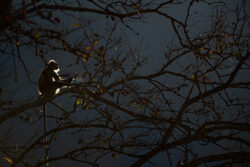The insect world is fascinating. These tiny creatures have thrived on our planet for millions of years, so they must be doing something right, despite all the threats to their survival. Many insects feed on plants, while some of them feed on other insects and spiders too. Spiders and insects interact all the time, in prey-predator relationships – one species is hunted as a food source by the other. Some predators devour their prey and others have piercing mouth parts which help them to suck the innards. Some are active hunters; they stalk and chase their prey to hunt them down, while some patiently hide and ambush unsuspecting victims that wander too close. To avoid getting hunted, they employ a variety of survival skills – acting dead, sacrificing one part of their body, spraying formic acid, pretending to look like debris, etc. Some of them take camouflage to the next level by mimicking shapes, colours and patterns of their habitat, thereby hiding in plain sight.

Lacewing larvae are called aphid lions because they feed on other insects as well as aphids. They are voracious feeders, attacking with large, curved, hollow mandibles. This is the most beneficial stage in the life of a lacewing. They prey on soft-bodied insects like aphids and also on caterpillars and some beetles. Their contribution to insect control is immense.

Some green lacewing larvae develop a camouflage cover which hides them from their prey and predators. They are called debris-carrying lacewing larvae because they pick up plant debris, lichen, and remains of their prey and attach all of it to their back. This camouflage makes them difficult to spot by their prey, natural enemies, and the inexperienced human eye.

Owlflies lay eggs on twigs or plant stems. Their larvae are ambush predators, and sequester themselves at the surface of the soil, in litter or on vegetation, and wait for prey. Their large mandibles help them hunt with ease. They resemble ant lion larvae, but have an elongate, sometimes finger-like appendage on the side of each segment. They are also known to cover themselves with debris.

Lynx spiders rely on their sharp eyesight to stalk, chase or ambush prey and also to avoid enemies. As with many other families of spiders, lynx spiders, in spite of largely being ambush hunters, are fast runners and leapers. Here is one with a larger prey, an adult owlfly.

In the majority of cases, a female spider kills and eats a male before, during, or after copulation. Cases in which males eat females are rare. In some cases, like the scene in the photograph, spiders will prey on their own kind and resort to cannibalism when food is scarce.

Bark mantis is refers to various species of praying mantis, especially those with camouflage resembling tree barks. They are highly predatory in nature and their camouflage helps them hunt a variety of insects, including moths, crickets, grasshoppers and flies. I have always seen lynx spiders predating on other insects or spiders, but for the first time I recorded a bark mantis preying on a lynx spider.

The insect world is full of surprises; here is a mantid, hunted down by a spider. Jumping spiders, like the Hyllus semicupreus photographed here, are very active and can be seen commonly among foliage and within tree trunks. They are known to eat small insects like grasshoppers, flies, bees as well as other small spiders.

The name robber fly reflects the notorious and aggressive predatory habits of these insects. They feed mainly or exclusively on other insects, like the one in the photograph that has hunted down a wasp. As a rule, they wait in ambush and catch their prey in flight. I think they are one of the strongest predators in the insect world!

Aggressive predators like robber flies are almost always seen with a kill, but as a rule of nature, predators will become prey one day. Here, an unlucky robber fly has turned out to be a great lunch for this intelligent female Hyllus semicupreus.

Not all spiders catch their prey by running or jumping, many build webs specifically designed to trap insects. Spiders like the Argiope aemula extrude silk from their spinnerets to catch prey. A poor grasshopper is sealed in a silken trap here.

Uloboridae is a family of non-venomous spiders; their lack of venom glands is a secondarily evolved trait. Instead, they wrap their prey thoroughly in silk, cover it in regurgitated digestive enzymes, and then ingest the liquefied body.

Monaeses is a genus of crab spiders in the family Thomisidae. Species of this genus inhabit plant stems, leafy or dry branches and grasses and are well camouflaged. Some are wandering hunters and are most widely known as ambush predators.
Ultimately, every predator is somebody else’s prey.





Instagram
junglelodgesjlr